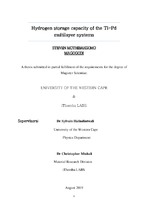| dc.contributor.advisor | Halindintwali, Sylvain | |
| dc.contributor.author | Magogodi, Steven Mothibakgomo | |
| dc.date.accessioned | 2020-12-09T10:35:50Z | |
| dc.date.available | 2020-12-09T10:35:50Z | |
| dc.date.issued | 2020 | |
| dc.identifier.uri | http://hdl.handle.net/11394/7711 | |
| dc.description | >Magister Scientiae - MSc | en_US |
| dc.description.abstract | Hydrogen has high energy density and it is regarded as the future energy carrier. Hydrogen can be stored as a gas in high-pressure cylinders, as a liquid in cryogenic tanks and as a solid in metal hydrides. The storage of hydrogen in gas and liquid form has many limitations. Light metal hydrides show high energy density and are a promising and more practical mode of hydrogen storage. In particular, titanium and its alloys are promising metal hydrides for hydrogen storage due to their high affinity to hydrogen. The aim of this study is to investigate the effect of thermal annealing on hydrogen storage capacity of Ti-Pd multilayer systems. Ti-Pd multilayer films were prepared on CP-Ti (commercial pure Ti) and Ti6Al4V substrates using an electron beam evaporator equipped with a thickness monitor. The sequential deposition of layers Pd(50nm)/Ti(25nm)/Pd(50nm) was done at a constant deposition rate of 0.6 Å/s. The first batch of samples were thermally annealed at 550 °C in vacuum for two hours, the second batch of samples were annealed at 550 oC under H2(15%)/Ar(85%) gas mixture for two hours and the third series of samples was annealed under pure H2 gas at 550 oC for one hour. SEM showed relatively homogeneous and smooth topography of surfaces in as-deposited samples, while a rough textured surface was observed in both samples annealed under vacuum and under H2/Ar gas mixture. The samples annealed under pure H2 gas did not show any sign of crystallites grow but instead a relatively smooth surface with sign of etching. XRD revealed structural transformation as evidenced by the presence of PdTi2 phase in samples annealed under vacuum; in samples annealed under the gas mixture Pd2Ti was noted in addition to TiH2 and TiO2. While the TiH2 phase is an indication of hydrogen absorption, the TiPd2 phase suggests intermixing of the deposited layers and the presence of TiO2 is evidence of oxidation. The samples annealed under pure H2 gas showed only TiH2 with no trace of structural transformation. RBS confirmed the intermixing of layers in the samples annealed under vacuum and H2(15%)/Ar(85%) gas mixture, while samples annealed under pure H2 gas did not show any intermixing of layers. ERDA revealed an average H content of ~ 3.5 at.% in CP-Ti and ~6.2 at.% in Ti6Al4V for samples annealed under H2(15%)/Ar(85%) gas mixture. We recorded an hydrogen content of ~19.5 at.% in CP-Ti annealed under pure H2 while ~25.5 at.% was found in Ti6Al4V annealed under the same conditions. When the thickness of the Pd catalyst layers was increased to 100 nm (i.e. Pd (100 nm)/Ti (25 nm)/Pd (100 nm)), only ~ 12.5 at.% and 11.2 at. % hydrogen content was recorded in samples prepared on CP-Ti and Ti6Al4V alloy respectively, both annealed under pure hydrogen for one hour as above. | en_US |
| dc.language.iso | en | en_US |
| dc.publisher | University of the Western Cape | en_US |
| dc.subject | Titanium | en_US |
| dc.subject | Ti6Al4V alloy | en_US |
| dc.subject | Electron beam evaporation | en_US |
| dc.subject | Thin film coatings | en_US |
| dc.subject | Multilayers | en_US |
| dc.subject | Palladium-Titanium | en_US |
| dc.subject | Hydrogenation | en_US |
| dc.subject | Hydrogen storage | en_US |
| dc.subject | Elastic Recoil | en_US |
| dc.subject | Detection Analysis | en_US |
| dc.subject | Scanning Electron Microscopy | en_US |
| dc.subject | Rutherford Backscattering Spectroscopy | en_US |
| dc.subject | Phase transformation | en_US |
| dc.title | Hydrogen storage capacity of the Ti-Pd multilayer systems | en_US |
| dc.rights.holder | University of the Western Cape | en_US |

